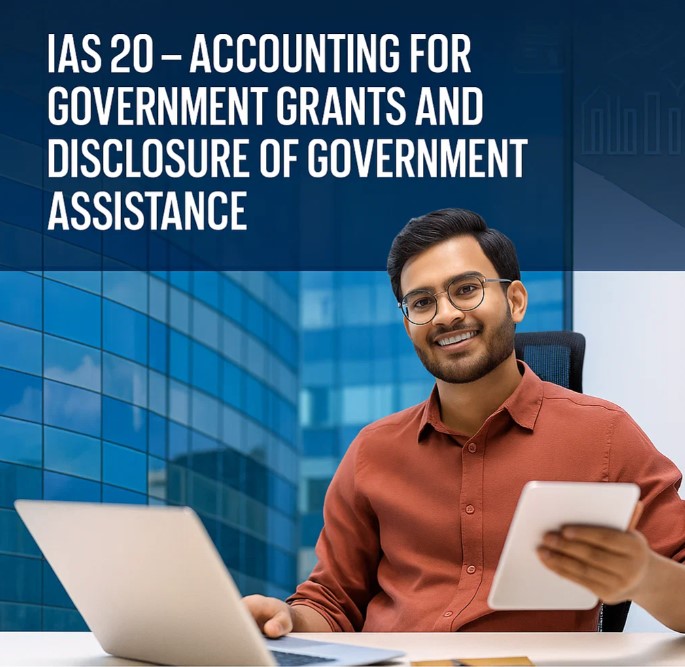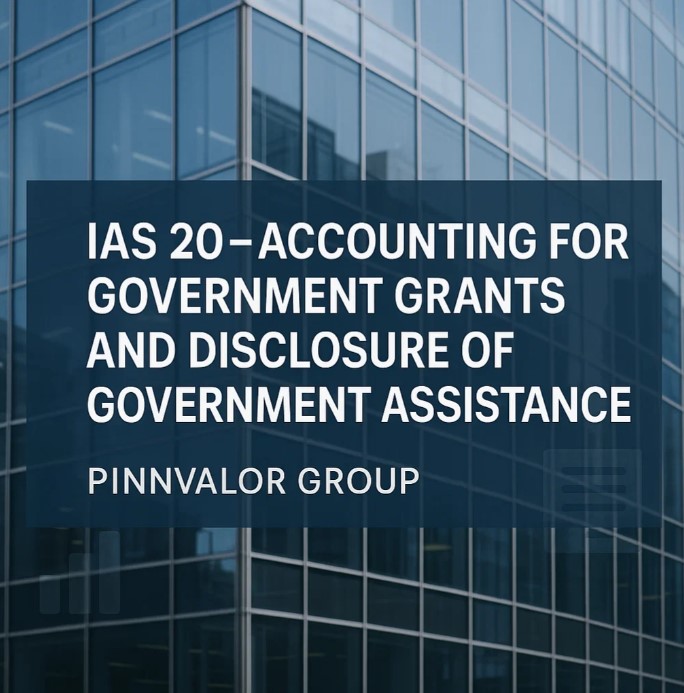
IAS 20 – Accounting for Government Grants and Disclosure of Government Assistance
Summary: This article explains the objective, scope, recognition, measurement, presentation and disclosure requirements of IAS 20, with practical examples and guidance for preparers of financial statements.
Wondering how to treat grants in your financial statements under IAS 20?
Compliance is more than a requirement—it’s the foundation of credibility. IAS 20 ensures grants are recognized the right way.
🎯 Objective
IAS 20 prescribes accounting for government grants and the disclosure of government assistance. The standard ensures grants are recognized and presented in a way that reflects their economic substance and provides transparent information to users of the financial statements.
📌 Scope
IAS 20 applies to:
- Accounting for government grants (monetary and non-monetary).
- Disclosure of government assistance.
IAS 20 does not apply to:
- Government participation in ownership (e.g., share subscriptions) — that is covered by other guidance.
- Tax benefits that are accounted for under IAS 12 Income Taxes.
📝 Key definitions
- Government grant — assistance by government in the form of transfers of resources to an entity in return for compliance with certain conditions relating to the entity’s operating activities.
- Government assistance — broader government action that provides economic benefits but may not be readily measurable (e.g., infrastructure, free technical advice).
- Grants related to assets — grants whose primary condition is that the entity acquires or constructs long-lived assets.
- Grants related to income — grants that are not related to assets and typically subsidize operating costs.
✅ Recognition
Recognize a government grant only when both of the following conditions are satisfied:
- There is reasonable assurance that the entity will comply with the conditions attached to the grant.
- There is reasonable assurance that the grant will be received.
Note: Mere receipt of funds is insufficient. Recognition depends on both receipt and compliance with conditions being reasonably assured.
💰 Measurement
Government grants should be measured at the fair value of the resources received or receivable.
Examples:
- Cash subsidy of USD 100,000 → recognize at USD 100,000.
- Free land granted → recognize the land at its fair value on the date of receipt.
📊 Presentation in financial statements
Grants related to assets
IAS 20 permits two alternative presentations for asset-related grants:
- Deferred income method: Record the grant as deferred income (liability) and recognize it in profit or loss over the useful life of the related asset.
- Net-off (capital) method: Deduct the grant from the carrying amount of the asset (i.e., present the asset net of the grant).
Effect on depreciation: Under the net-off method, depreciation is computed on a reduced carrying amount; under the deferred income method, depreciation is computed on the full cost and the deferred income is amortized separately.
Grants related to income
Recognize income-related grants on a systematic basis in profit or loss over the periods in which the related costs are incurred. Presentation options include:
- Present as "Other income" (separate line in P&L), or
- Deduct from the related expense in the statement of profit or loss.
🔄 Repayment of grants
If a grant becomes repayable (e.g., conditions breached), IAS 20 requires:
- For income-related grants: reduce any unamortized deferred income first; any excess repayment is charged to profit or loss.
- For asset-related grants: either increase the carrying amount of the related asset or reduce deferred income; any resulting depreciation adjustments are made prospectively.
🏛 Government assistance (other than grants)
Governments sometimes provide assistance that does not take the form of direct grants — for example, tax holidays, free advisory services, or provision of infrastructure. IAS 20 requires disclosure of material government assistance even if it is not recognized as a grant in the financial statements.
📢 Disclosure requirements
Entities must disclose the following for each period presented:
- The accounting policy applied for government grants.
- The nature and extent of government grants recognized in the financial statements.
- Unfulfilled conditions and other contingencies attaching to recognized grants.
- Information about government assistance not recognized in the financial statements but from which the entity has directly benefited.
📌 Practical examples
Example 1 — Asset-related grant
Facts: Company A receives a government grant of USD 200,000 to acquire machinery costing USD 1,000,000.
- Deferred income method: Record machinery at USD 1,000,000; record a deferred income liability of USD 200,000; recognize amortization of deferred income over the machinery’s useful life.
- Net-off method: Record machinery at USD 800,000 (1,000,000 − 200,000) and depreciate that amount over the useful life.
Example 2 — Income-related grant
Facts: Company B receives wage subsidies of USD 50,000 towards payroll costs this year.
- Recognize USD 50,000 in profit or loss on a systematic basis in the same periods in which the related payroll expense is recognized.
- Presentation choices: show USD 50,000 as “Other income” or present it as a reduction of payroll expense (company’s choice but disclose policy).

⚖️ Benefits and policy considerations
- Transparency: IAS 20 ensures stakeholders can see how government grants affect performance and position.
- Consistency: The standard allows consistent treatment across reporting periods, but entities must disclose the policy chosen (deferred income vs net-off).
- Judgement & estimates: Management must exercise judgement when deciding whether conditions are reasonably assured and in measuring fair value of non-monetary grants.
✅ Quick checklist for preparers
- Has the grant been received or is it receivable? Is there reasonable assurance of compliance with conditions?
- Is the grant related to an asset or income?
- Measure the grant at fair value on receipt/recognition.
- Decide presentation: deferred income or net-off for asset grants; other income or deduction for income grants.
- Disclose policy, amounts, unfulfilled conditions, and any non-recognized government assistance.
📚 Useful IFRS cross references
- IAS 12 Income Taxes — for tax-related government measures and recognition of tax consequences.
- IAS 16 Property, Plant and Equipment — for accounting and depreciation of asset purchases financed by grants.
- IAS 20 itself for authoritative guidance and examples.
🧾 Sample disclosure (concise)
Accounting policy: Government grants are recognized when there is reasonable assurance that the entity will comply with the attached conditions and that the grant will be received. Grants related to assets are presented either as deferred income and recognized in profit or loss over the useful life of the asset, or deducted from the carrying amount of the asset. Grants related to income are recognized in profit or loss on a systematic basis in the periods in which the related expenses are incurred.
Amounts recognized: Government grants recognized in profit or loss during the year amounted to USD X (prior year: USD Y). Unfulfilled conditions related to grants amounted to USD Z at year end.